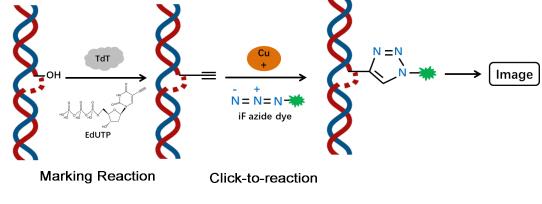Cell Apoptosis Detection Kit
Click-iT 488 Tunel Cell Apoptosis Detection Kit

Product Description
The breaking of chromosomal DNA in apoptosis is a gradual, phased process. Chromosomal DNA is first degraded into large 50-300 kb segments by endogenous nucleic acid hydrolases, and then about 30% of chromosomal DNA is randomly cut between nucleosome units in the presence of Ca2+- and Mg2+-dependent nucleic acid endonucleases to form 180-200 bp nucleosomal DNA multimers.Thus, in late apoptosis, DNA is degraded into 180-200 bp fragments, and a large number of 3'-OH ends are exposed on the broken genomic DNA. Terminal Deoxynucleotidyl Transferase (TdT) is a template-independent DNA polymerase that catalyzes the incorporation of deoxyribonucleotides into the 3'-OH ends of broken DNA molecules.Therefore TUNEL (TdT mediated dUTP Nick End Labeling) Cell Apoptosis Detection Kit can be used to detect the breakage of nuclear DNA in tissue cells during late apoptosis.
The principle is that under the action of TdT enzyme, EdUTP (a dUTP with alkyne modification) is doped into the 3´-OH end exposed during genomic DNA breakage, and the alkyne group reacts with the azide dye in a ring-forming reaction catalyzed by a monovalent copper ion (click reaction) thus introducing the fluorescent moiety in a targeted way. iF488 azide is used in this kit, thus it can be detected by fluorescence microscope or flow cytometry (iF488 excitation 491 nm, emission 516 nm). Compared to other modified dUTPs, EdUTP has a smaller spatial site resistance and is more easily doped into DNA ends by TdTase.
This kit has a wide range of applications and is suitable for apoptosis detection in paraffin tissue sections, frozen tissue sections, cell crawls and cell smears.
Katalog Nummer: 25-4010 CELL
DESCRIPTION [270 KB]
Germany:
Sansunbiologics
CONTACT US
Sansunbiologics
Eurotec Ring 15
47445 Moers
CONTACT:Hongyan Shi
EMAIL:info@sansunbiologics.com
Annexin V-FITC / PI Cell Apoptosis Kit
Product Description
Useful for DNA analysis and dead cell discrimination during flow cytometric analysis.
Annexin V is a member of the annexin family, which binds to phosphatidylserine (PS) in a calcium-dependent manner. The Annexin V-labeled fluorescein bind specifically to the PS on the outer leaflet apoptotic cell membrane and can be detected with flow cytometry or fluorescence microscope. Nuclear dyes (PI, DAPI, 7-AAD) have a high DNA binding constant and is efficiently excluded by intact cells. It is useful for DNA analysis and dead cell discrimination during flow cytometric analysis. Due to late apoptosis or loss of membrane integrity in necrotic cells, nuclear dyes can enter cells to stain DNA, and when used in combination with Annexin V, cells in different apoptotic stages can be distinguished.
Caution: Propidium Iodide Solution is toxigenic and mutagenic, handle with care.
DAPI flow cytometry has a place - especially in lower-complexity experiments or when you're working with unfixed cells. In fact, DAPI remains a reliable, low-cost option for a range of applications, including:
Live-cell sorting: If you are using FACS to isolate viable cells for culture or RNA extraction, DAPI is ideal because it’s non-toxic and washes away easily.
Simple viability gating: DAPI is still a fast and cost-effective way to exclude dead cells.
Cell cycle analysis: For fixed cells treated with RNase A, DAPI provides high-resolution DNA content data. It's great for checking cell proliferation or drug-induced arrest.
Functional assays: In ROS or mitochondrial potential studies, researchers often combine DAPI with other dyes to ensure they’re only measuring live cells.
General Information
Application Annexin V
Detection method: Fluorometric Method
Sample type Cell samples
Assay time 40min
Detection instrument: Flow Cytometer
Dye Type FITC
Ex/Em (nm) 490/530
Channel set FITC
Katalog Nummer: 25-4030 CELL
Germany:
Sansunbiologics
CONTACT US
Sansunbiologics
Eurotec Ring 15
47445 Moers
CONTACT:Hongyan Shi
EMAIL:info@sansunbiologics.com
Zugriffe heute: 2 - gesamt: 241.
